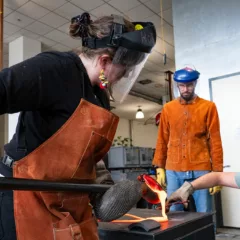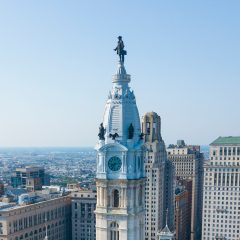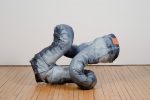Post by John Vick
Execution is essential to understanding. The way in which an idea is conveyed, a picture made, or an installation constructed greatly influences the viewer’s interpretation of the piece. This is true regardless of artistic intents or aesthetic penchants. Even with supplemental information, such as wall text or artist’s statements, poorly executed work will be neither convincing nor appealing.
The limits of our curiosity and imagination require craft to make up that deficit.[1] If viewers are not stimulated by what they see, they will struggle to form a relationship with the work. Viewers must also be able to translate sensory stimulation into some sort of meaning, be it independent of or in harmony with the artist’s motivation for creating the work. If this translation does not happen the viewer-object relationship becomes only a passing fling.
Of course, successful execution is highly subjective. Artists spend entire careers refining their craft. They repeat subjects and replicate styles endlessly toward perfection. Aesthetic and cultural trends change over time, making that search for ideal execution all the more difficult. These unfavorable odds aside, Philadelphia currently boasts several exhibitions that rather successfully assert the merits of good execution and its place in contemporary art. Among them are Tristin Lowe’s Mocha Dick recently at the Fabric Workshop and Museum, the work of Myra Mimlitsch-Gray at Wexler Gallery, and Lee Stoetzel’s Big Bike at the Galleries at Moore.
Mocha Dick is a white sperm whale 52 feet in length. That Tristin Lowe, working with the FWM studio, built the whale with industrial felt, thread, zippers, and an internal vinyl support system changes little. Mocha Dick is still a whale. The fibrous felt really appears to be blubbery skin. Cleanly stitched lines meander the body like scars and wrinkles. Appliqued barnacles pock the surface, as do the inset holes and protruding bumps that make for convincing wounds and healing tissue. Overall, each curve and contour, volume and mass, is true to nature. Even the zippers, functional necessities for joining separate pieces of felt around the inflated core, create a texture that, if not anatomically accurate, at least follows the animal’s structure with graceful subtlety.
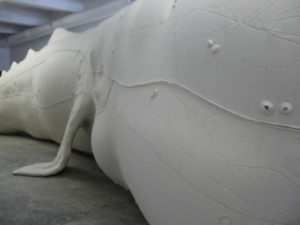
Lowe’s attention to detail makes viewing Mocha Dick feel like an encounter with a whale. To marvel at the artist’s skillful work is to contemplate the bodily equivalent each stitch represents. It is an experience more authentic than seeing Damien Hirst’s The Physical Impossibility of Death in the Mind of Someone Living, which consists of an actual dead tiger shark in formaldehyde. (As Hirst’s shark continues to decompose, that comparison will only become truer.) No, the felt whale is not real, but Lowe allows viewers to suspend disbelief and imagine that they are confronting the leviathan that tormented sailors in the South Seas and later inspired Meville to write Moby-Dick. The emotions or thoughts this interaction might generate – be they panic, intrigue, compassion, or loss – are precisely what Lowe seeks to elicit.[2]
Myra Mimlitsch-Gray’s altered kitchenwares at Wexler Gallery combine recognizable objects with improbable shapes. Bowl and Saucer is made of “given silver by Sharon Church” set into a silver base. Suspended at irregular angles, the bowl and saucer seem truly wedded to the slick pool below. Other objects, all cast in iron, resemble hearty cookware deformed beyond belief: twelve elongated Brat Pans hang neatly in a row on a wall; Freestanding Skillet sits upright on its one flattened, stretched edge; Four-Handled Skillet merges (or splits) two two-handled skillets, themselves total oddities.
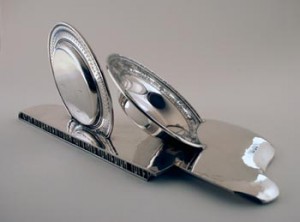
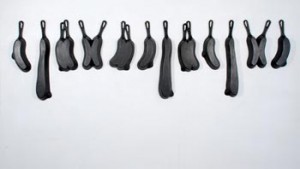
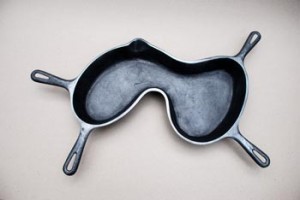
These conundrums of silver and iron straddle a boundary between real and absurd that is mitigated by expert treatment of material and proportion. Bowl and Saucer is in fact an actual bowl and saucer made for Mimlitsch-Gray by another artist, but the silver dishes have been arranged to produce curious effects.[3] The scene is in one sense magical, the instantaneous transformation of molten silver into finished goods, and back again. Yet it also illustrates the mundane task of washing dishes. Meanwhile, Mimlitsch-Gray’s iron objects, which are entirely custom cast, seem somehow utilitarian despite their lack of function. The Brat Pans almost beg viewers to fry up foot-long sausages, or find three friends to help make a big omelet in Four-Handled Skillet.
Big Bike, by Lee Stoetzel, is a fixed-gear bicycle unlike any other. As the name indicates, it is massive, roughly twice normal size. From stem to crank and wheel to wheel, Big Bike is also built entirely of wood. The inclusion of so many small details – from the individual chain links to the rear tire’s air valve – might propel viewers to climb on and ride away. If only they were so tall. Stoetzel’s choice of wood, though, is of equal note. Fractured mesquite, a natural degraded wood, has a grain marked by irregular holes and grooves. In Big Bike, such material inconsistencies translate as the grime and wear expected of a city bike. They also streak across the object like lines simulating motion.
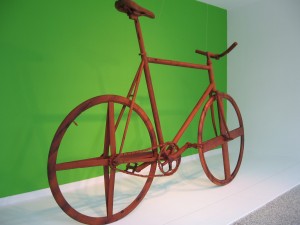
Because Stoetzel has modeled his giant wooden bike so perfectly after its smaller, mostly metal relative, the difference in material and size are all the more evident. Were the wheels not true nor the frame correctly proportioned, this would not be so. But since such inaccuracies do not cloud the viewer’s engagement, they may instead contemplate how Stoetzel’s use of wood and enlarged scale influence the object’s reading. Is Big Bike just fantasy, a once functional but now deteriorating relic of an extinct superhuman race? Or is there a socially relevant parallel between the natural materials and cycling’s environmental benefits? Perhaps a more physical reading is instead expected: the bike, though ostensibly fragile, is sturdy, a powerhouse both on the streets and in our imaginations.
Taken as three separate examples, the work of Tristin Lowe, Myra Mimlitsch-Gray, and Lee Stoetzel together exemplify how careful execution can be the foundation for expressing abstract and transcendent ideas. They also point to the use of illusion as a key device for instigating a deeper art experience. More accurately, they maintain altered illusions, wherein normalcy is upset in limited ways. Flesh becomes fabric with Lowe, Mimlitsch-Gray disfigures familiar cookware, and Stoetzel replaces one part metal and rubber with two parts wood, but other variables remain constant. The unchanged and recognizable characteristics end up being the viewer’s introduction to the work.
This modified illusionism, and the degree of precision requires, also highlights each artist’s use of materials – fabric, metal, and wood – traditionally assumed under the heading of craft. While such usage in contemporary art is nothing new, craft remains a tricky word. It refers to a set of practiced skills, a process by which something is made, or even the visual qualities of a finished product. It also identifies certain categories of objects and specific historical movements. Most provocatively, and somewhat perplexingly, craft is regularly used as a foil to art, implying that since craft is very focused on materiality, then art asserts meaning beyond itself.[4]
This belief is prevalent, however generalized it may be. Art is commonly understood in terms of broader concepts, as most exhibition labels, artist statements, and art history books will attest. Craft, on the other hand, seems contently introverted, focusing on physical characteristics to the point of fetishization. This dichotomy is flawed, though. Not only does it allow art to be sloppy and permit craft to be dull, but it encourages polarized camps of allegiance. Worse, it ignores artists like Lowe, Mimlitsch-Gray, and Stoetzel who, in refusing such definitions, create work that is both intellectual provocative and visually striking.
John Vick is a curatorial fellow in the Department of Prints, Drawings, and Photographs at the Philadelphia Museum of Art. He has a Master’s degree in Art History from the University of Pennsylvania.
Notes:
[1] Our busy and distracted lives and interactions are also limited factors – see the May 22 posting “One Quiet & One Loud.”
[2] More of Lowe’s finely made, full-scale felt sculptures were on view at the Fleisher/Ollman Gallery. The works there relating to Mocha Dick prompted similar feeling of unlikely confrontation. Lowe’s quotidian objects, such as a chair and whiskey bottle, also on view, emphasized the beauty of his handiwork and suggested a softer, even tired, version of reality. Also see Libby’s review of the FWM show.
[3] Such usage is reminiscent of Robert Rauschenberg’s 1953 Erased de Kooning Drawing or Martin Kippenberger’s Modell Interconti, a 1987 table made from a Gerhard Richter painting.
[4] Note for further reading: The recent book Thinking Though Craft, by Glenn Adamson, does a lot to address the complex interplay between art and craft. It is excellent in both content and organization. Rather than try to precisely situate one term against the other, Adamson considers general perceptions of craft and gives examples of where such principles intersect with modern and contemporary art. A more thorough review and summary of the book can be found in the September 2008 issue of Art in America.


